Co-Digestion of Salix and Manure for Biogas: Importance of Clone Choice, Coppicing Frequency and Reactor Setup
Abstract
:1. Introduction
2. Materials and Methods
2.1. Field Trial and Substrates
2.2. Biomethanation Potential Assay
2.3. Continuous Digestion Experiments
2.3.1. Single-Stage Continuous Digestion
2.3.2. Sequential Continuous Digestion
2.4. Chemical Analyses
2.5. Calculations and Statistical Analyses
3. Results and Discussion
3.1. Field Experiment Biomass Yields
3.2. Biomethanation Potentials
3.3. Co-Digestion of Salix and Manure
3.4. Effect of Co-Digestion on Digestate
3.5. Area Requirements and Estimated Yields from Co-Digestion of Salix in Farm Scale Digesters
4. Conclusions
Supplementary Materials
Author Contributions
Funding
Acknowledgments
Conflicts of Interest
References
- Scarlat, N.; Dallemand, J.-F.; Fahl, F. Biogas: Developments and perspectives in Europe. Renew. Energy 2018, 129, 457–472. [Google Scholar] [CrossRef]
- European Biomass Association. A Biogas Road Map for Europe. Available online: http://www.aebiom.org/IMG/pdf/Brochure_BiogasRoadmap_WEB.pdf (accessed on 10 July 2020).
- Lönnqvist, T.; Silveira, S.; Sanches-Pereira, A. Swedish resource potential from residues and energy crops to enhance biogas generation. Renew. Sustain. Energy Rev. 2013, 21, 298–314. [Google Scholar] [CrossRef]
- Scarlat, N.; Fahl, F.; Dallemand, J.-F.; Monforti, F.; Motola, V. A spatial analysis of biogas potential from manure in Europe. Renew. Sustain. Energy Rev. 2018, 94, 915–930. [Google Scholar] [CrossRef]
- Hagos, K.; Zong, J.; Li, D.; Liu, C.; Lu, X. Anaerobic co-digestion process for biogas production: Progress, challenges and perspectives. Renew. Sustain. Energy Rev. 2017, 76, 1485–1496. [Google Scholar] [CrossRef]
- Monlau, F.; Barakat, A.; Trably, E.; Dumas, C.; Steyer, J.-P.; Carrère, H. Lignocellulosic Materials into Biohydrogen and Biomethane: Impact of Structural Features and Pretreatment. Crit. Rev. Environ. Sci. Technol. 2013, 43, 260–322. [Google Scholar] [CrossRef]
- Börjesson, P.I.I. Energy analysis of biomass production and transportation. Biomass Bioenergy 1996, 11, 305–318. [Google Scholar] [CrossRef]
- Boehmel, C.; Lewandowski, I.; Claupein, W. Comparing annual and perennial energy cropping systems with different management intensities. Agric. Syst. 2008, 96, 224–236. [Google Scholar] [CrossRef]
- De Wit, M.; Faaij, A. European biomass resource potential and costs. Biomass Bioenergy 2010, 34, 188–202. [Google Scholar] [CrossRef]
- Lijó, L.; Lorenzo-Toja, Y.; González-García, S.; Bacenetti, J.; Negri, M.; Moreira, M.T. Eco-efficiency assessment of farm-scaled biogas plants. Bioresour. Technol. 2017, 237, 146–155. [Google Scholar] [CrossRef]
- Ericsson, N.; Nordberg, A.; Sundberg, C.; Ahlgren, S.; Hansson, P.-A. Climate impact and energy efficiency from electricity generation through anaerobic digestion or direct combustion of short rotation coppice willow. Appl. Energy 2014, 132, 86–98. [Google Scholar] [CrossRef] [Green Version]
- Li, C.; Sun, L.; Simmons, B.A.; Singh, S. Comparing the Recalcitrance of Eucalyptus, Pine, and Switchgrass Using Ionic Liquid and Dilute Acid Pretreatments. BioEnergy Res. 2013, 6, 14–23. [Google Scholar] [CrossRef]
- Healey, A.L.; Lupoi, J.S.; Lee, D.J.; Sykes, R.W.; Guenther, J.M.; Tran, K.; Decker, S.R.; Singh, S.; Simmons, B.A.; Henry, R.J. Effect of aging on lignin content, composition and enzymatic saccharification in Corymbia hybrids and parental taxa between years 9 and 12. Biomass Bioenergy 2016, 93, 50–59. [Google Scholar] [CrossRef] [Green Version]
- Chundawat, S.P.S.; Beckham, G.T.; Himmel, M.E.; Dale, B.E. Deconstruction of Lignocellulosic Biomass to Fuels and Chemicals. Annu. Rev. Chem. Biomol. Eng. 2011, 2, 121–145. [Google Scholar] [CrossRef] [PubMed] [Green Version]
- Teghammar, A.; Forgács, G.; Sárvári Horváth, I.; Taherzadeh, M.J. Techno-economic study of NMMO pretreatment and biogas production from forest residues. Appl. Energy 2014, 116, 125–133. [Google Scholar] [CrossRef] [Green Version]
- Ohlsson, J.A.; Harman-Ware, A.E.; Sandgren, M.; Schnürer, A. Biomass Recalcitrance in Willow Under Two Biological Conversion Paradigms: Enzymatic Hydrolysis and Anaerobic Digestion. BioEnergy Res. 2019, 311, 1–11. [Google Scholar] [CrossRef] [Green Version]
- Weih, M.; Hansson, P.-A.; Ohlsson, J.A.; Sandgren, M.; Schnürer, A.; Rönnberg Wästljung, A.C. Sustainable production of willow for biofuel use. In Achieving Carbon-Negative Bioenergy Systems from Plant Materials; Saffron, C., Ed.; Burleigh Dodds Science Publishing: Cambridge, UK, 2020; pp. 1–36. [Google Scholar] [CrossRef]
- Olsson, M.; Samils, B. Site Characterization at Energy Forest Production; Department of Forest Soils, Swedish University of Agricultural Sciences: Uppsala, Sweden, 1984. [Google Scholar]
- Schnürer, A.; Bohn, I.; Moestedt, J. Protocol for Start-Up and Operation of CSTR Biogas Processes. In Hydrocarbon and Lipid Microbiology Protocols; McGenity, T., Timmis, K., Nogales, B., Eds.; Springer: Berlin/Heidelberg, Germany, 2016; Volume 44, pp. 171–200. [Google Scholar]
- ISO 13878. Soil Quality—Determination of Total Nitrogen Content by Dry Combustion (Elemental Analysis); International Organization for Standardization (ISO): Geneva, Switzerland, 1998. [Google Scholar]
- ISO 10694. Soil Quality–Determination of Organic and Total Carbon after Dry Combustion (Elementary Analysis); International Organization for Standardization (ISO): Geneva, Switzerland, 1998. [Google Scholar]
- Westerholm, M.; Hansson, M.; Schnürer, A. Improved biogas production from whole stillage by co-digestion with cattle manure. Bioresour. Technol. 2012, 114, 314–319. [Google Scholar] [CrossRef]
- Westerholm, M.; Roos, S.; Schnürer, A. Syntrophaceticus schinkii gen. nov., sp. nov., an anaerobic, syntrophic acetate-oxidizing bacterium isolated from a mesophilic anaerobic filter. FEMS Microbiol. Lett. 2010, 309, 100–104. [Google Scholar] [CrossRef] [Green Version]
- Bates, D.; Mächler, M.; Bolker, B.; Walker, S. Fitting Linear Mixed-Effects Models Using lme4. J. Stat. Softw. 2015, 67, 1–48. [Google Scholar] [CrossRef]
- R Core Team. R: A Language and Environment for Statistical Computing; R Foundation for Statistical Computing: Vienna, Austria, 2020. [Google Scholar]
- Lenth, R. Emmeans: Estimated Marginal Means, AKA Least-Squares Means, R package version 1.4.7. 2020. Available online: https://cran.r-project.org/web/packages/emmeans/index.html (accessed on 24 July 2020).
- Ahlberg-Eliasson, K.; Nadeau, E.; Levén, L.; Schnürer, A. Production efficiency of Swedish farm-scale biogas plants. Biomass Bioenergy 2017, 97, 27–37. [Google Scholar] [CrossRef]
- Mola-Yudego, B.; Díaz-Yáñez, O.; Dimitriou, I. How Much Yield Should We Expect from Fast-Growing Plantations for Energy? Divergences Between Experiments and Commercial Willow Plantations. BioEnergy Res. 2015, 8, 1769–1777. [Google Scholar] [CrossRef]
- Adler, A.; Verwijst, T.; Aronsson, P. Estimation and relevance of bark proportion in a willow stand. Biomass Bioenergy 2005, 29, 102–113. [Google Scholar] [CrossRef]
- Serapiglia, M.J.; Cameron, K.D.; Stipanovic, A.J.; Smart, L.B. Analysis of Biomass Composition Using High-Resolution Thermogravimetric Analysis and Percent Bark Content for the Selection of Shrub Willow Bioenergy Crop Varieties. BioEnergy Res. 2009, 2, 1–9. [Google Scholar] [CrossRef]
- McCann, M.C.; Carpita, N.C. Biomass recalcitrance: A multi-scale, multi-factor, and conversion-specific property. J. Exp. Bot. 2015, 66, 4109–4118. [Google Scholar] [CrossRef] [PubMed] [Green Version]
- Sykes, R.; Kodrzycki, B.; Tuskan, G.; Foutz, K.; Davis, M. Within tree variability of lignin composition in Populus. Wood Sci. Technol. 2008, 42, 649–661. [Google Scholar] [CrossRef]
- Mata-Alvarez, J.; Dosta, J.; Romero-Güiza, M.S.; Fonoll, X.; Peces, M.; Astals, S. A critical review on anaerobic co-digestion achievements between 2010 and 2013. Renew. Sustain. Energy Rev. 2014, 36, 412–427. [Google Scholar] [CrossRef]
- Estevez, M.M.; Linjordet, R.; Morken, J. Effects of steam explosion and co-digestion in the methane production from Salix by mesophilic batch assays. Bioresour. Technol. 2012, 104, 749–756. [Google Scholar] [CrossRef]
- Estevez, M.M.; Sapci, Z.; Linjordet, R.; Schnürer, A.; Morken, J. Semi-continuous anaerobic co-digestion of cow manure and steam-exploded Salix with recirculation of liquid digestate. J. Environ. Manag. 2014, 136, 9–15. [Google Scholar] [CrossRef]
- Li, R.; Tan, W.; Zhao, X.; Dang, Q.; Song, Q.; Xi, B.; Zhang, X. Evaluation on the Methane Production Potential of Wood Waste Pretreated with NaOH and Co-Digested with Pig Manure. Catalysts 2019, 9, 539. [Google Scholar] [CrossRef] [Green Version]
- Lynd, L.R.; Liang, X.; Biddy, M.J.; Allee, A.; Cai, H.; Foust, T.; Himmel, M.E.; Laser, M.S.; Wang, M.; Wyman, C.E. Cellulosic ethanol: Status and innovation. Curr. Opin. Biotechnol. 2017, 45, 202–211. [Google Scholar] [CrossRef] [Green Version]
- Eggeman, T.; Elander, R.T. Process and economic analysis of pretreatment technologies. Bioresour. Technol. 2005, 96, 2019–2025. [Google Scholar] [CrossRef]
- Hopfner-Sixt, K.; Amon, T.; Bodiroza, V.; Kryvoruchko, V.; Milanovic, D.; Zollitsch, W.; Boxberger, J. Biogas Production from Agricultural Raw Materials: Characteristic Values for Assessing Material and Energy. Landtechnik 2006, 61, 148–149. [Google Scholar]
- Alburquerque, J.A.; de la Fuente, C.; Bernal, M.P. Chemical properties of anaerobic digestates affecting C and N dynamics in amended soils. Agric. Ecosyst. Environ. 2012, 160, 15–22. [Google Scholar] [CrossRef]
- Eich-Greatorex, S.; Vivekanand, V.; Estevez, M.M.; Schnürer, A.; Børresen, T.; Sogn, T.A. Biogas digestates based on lignin-rich feedstock—Potential as fertilizer and soil amendment. Arch. Agron. Soil Sci. 2017, 64, 347–359. [Google Scholar] [CrossRef]
- Stürmer, B.; Pfundtner, E.; Kirchmeyr, F.; Uschnig, S. Legal requirements for digestate as fertilizer in Austria and the European Union compared to actual technical parameters. J. Environ. Manag. 2020, 253, 109756. [Google Scholar] [CrossRef]
- Pulford, I.D.; Riddell-Black, D.; Stewart, C. Heavy Metal Uptake by Willow Clones from Sewage Sludge-Treated Soil: The Potential for Phytoremediation. Int. J. Phytoremediat. 2002, 4, 59–72. [Google Scholar] [CrossRef]
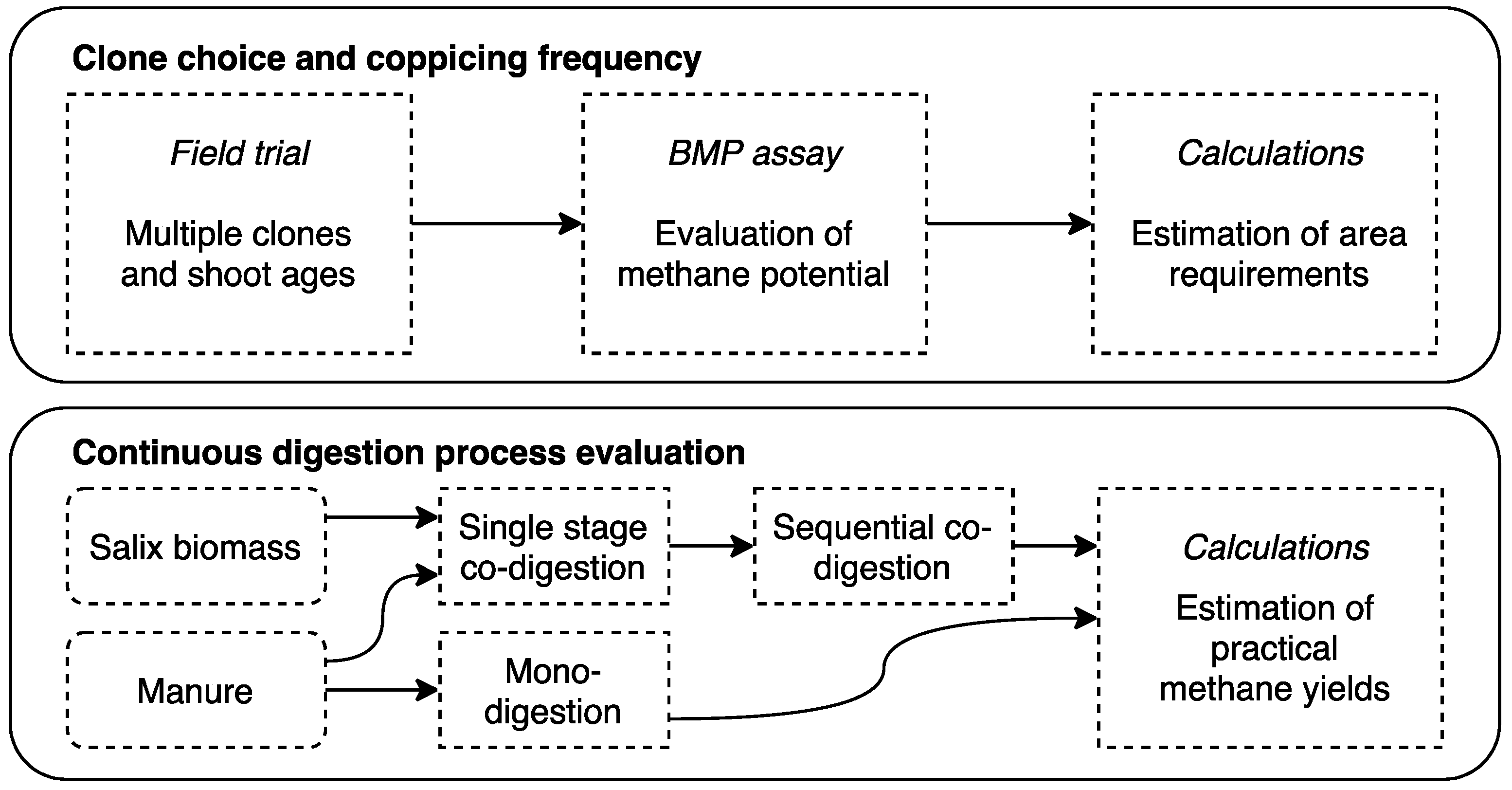

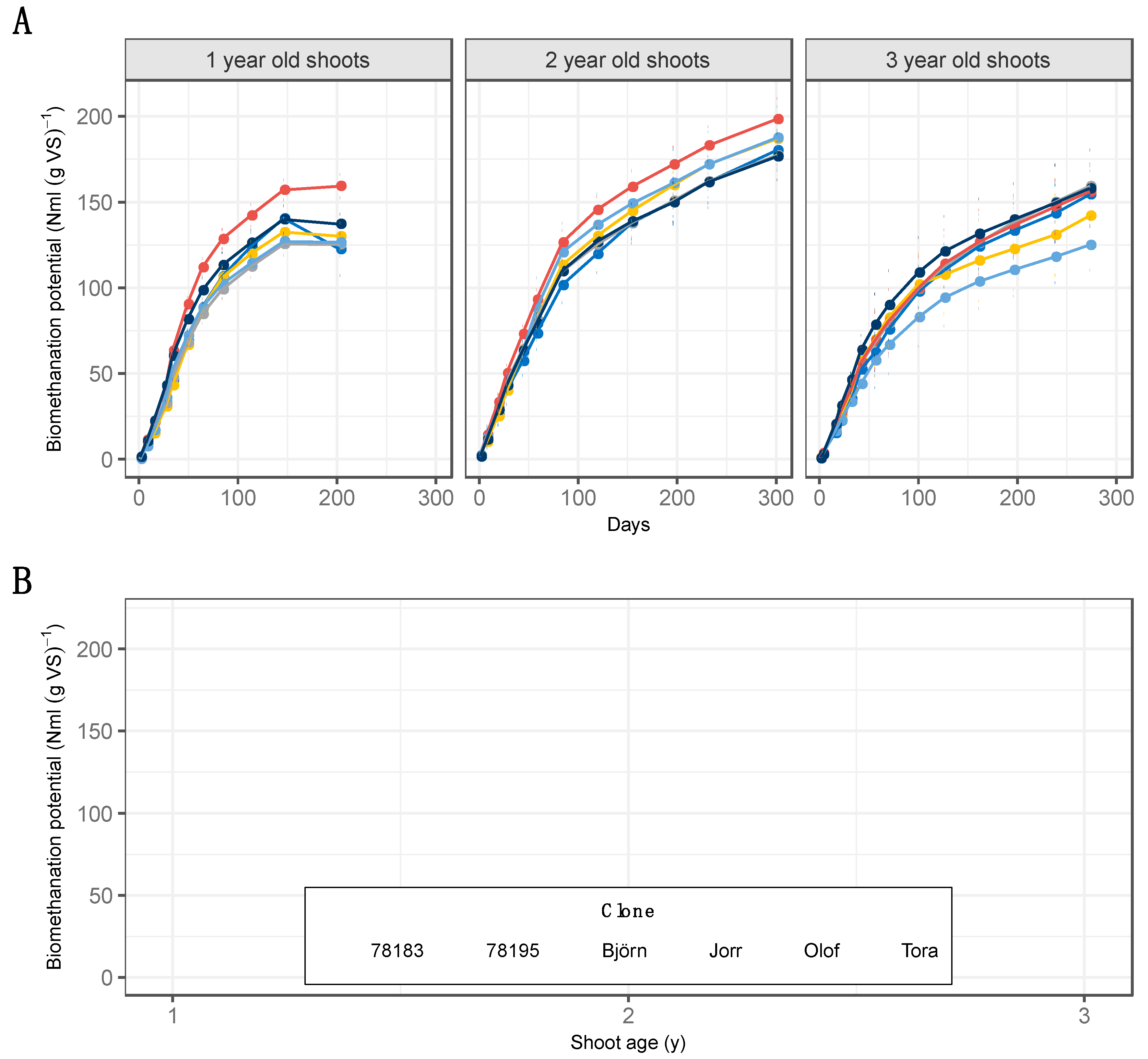
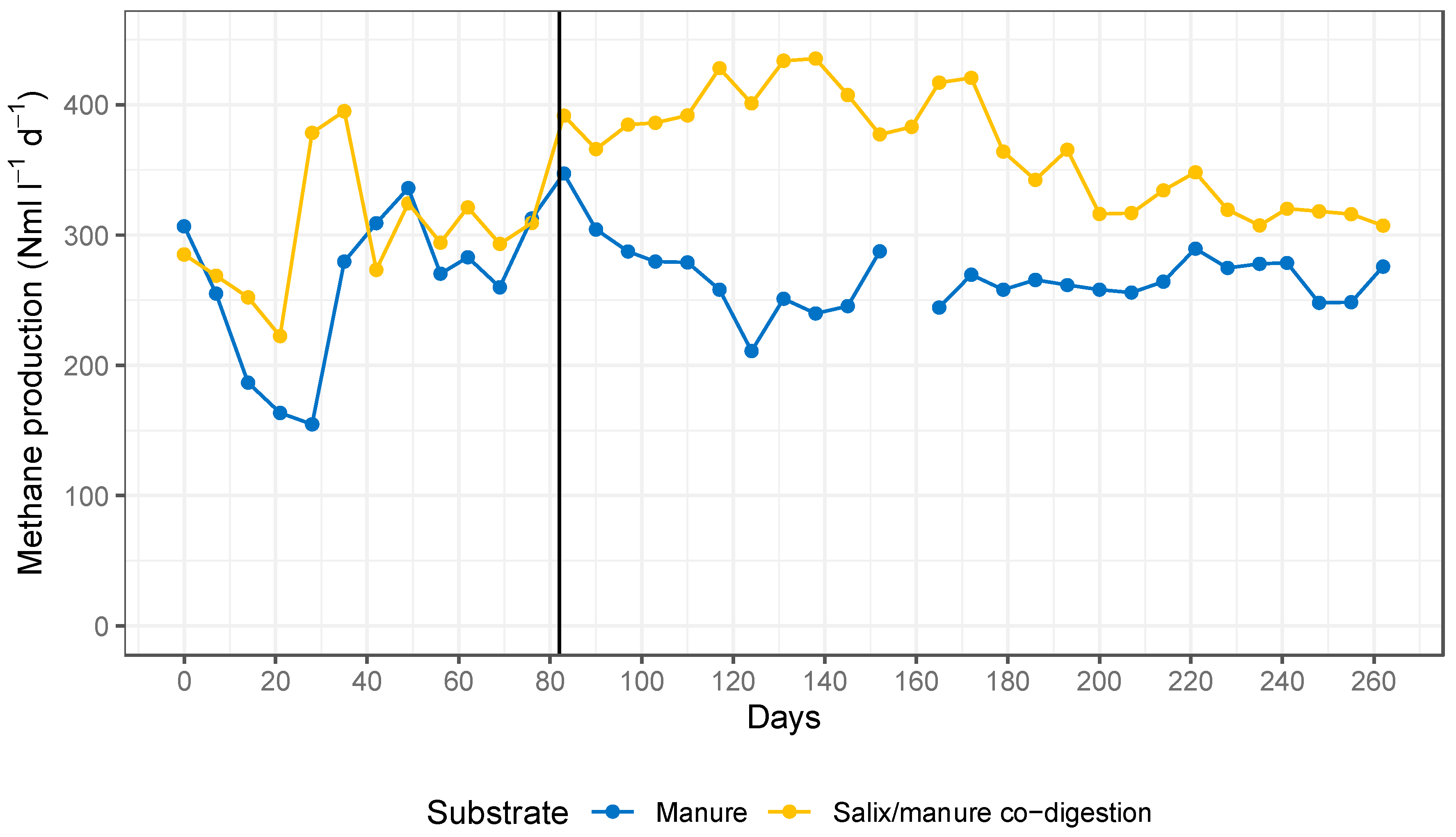
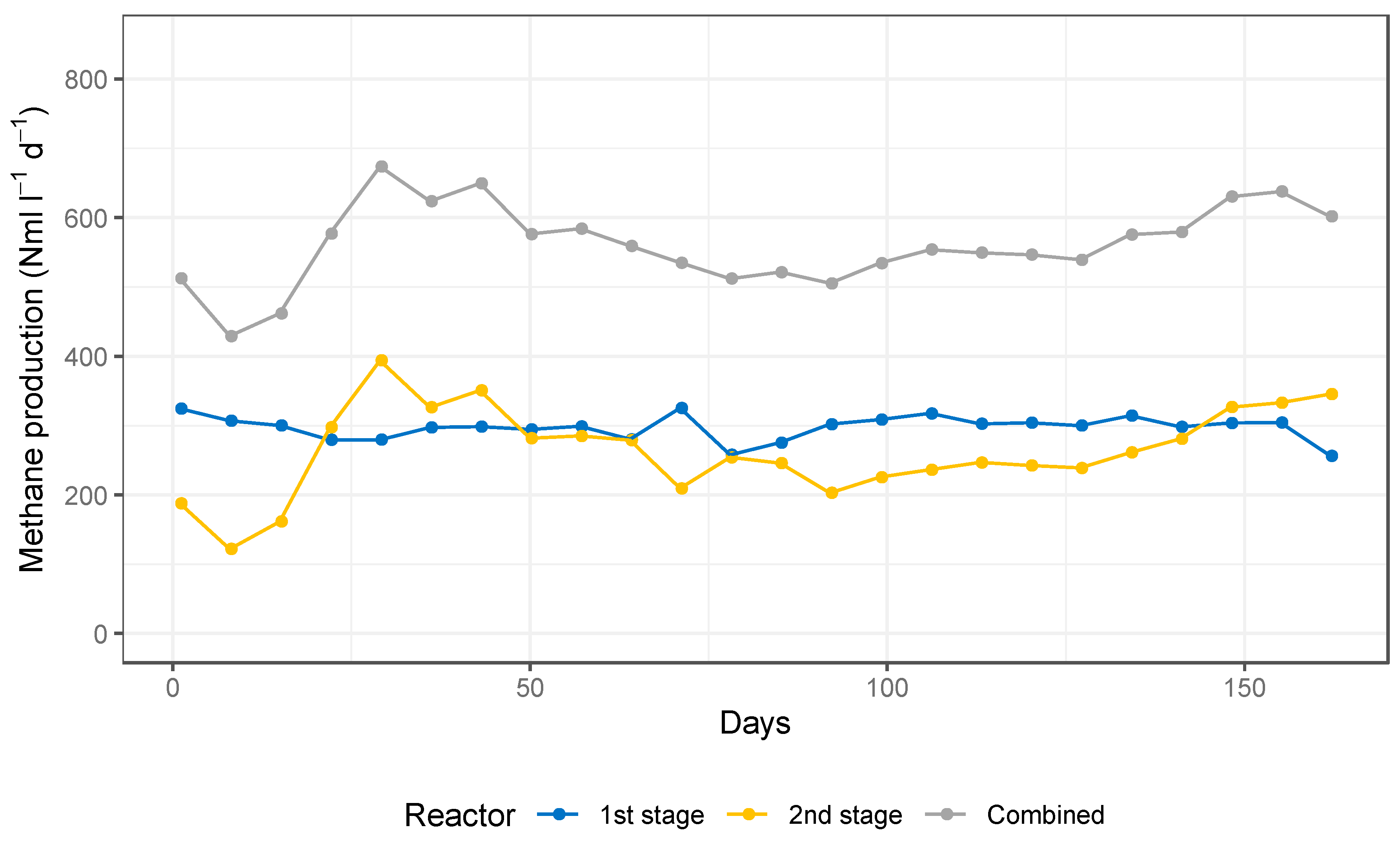
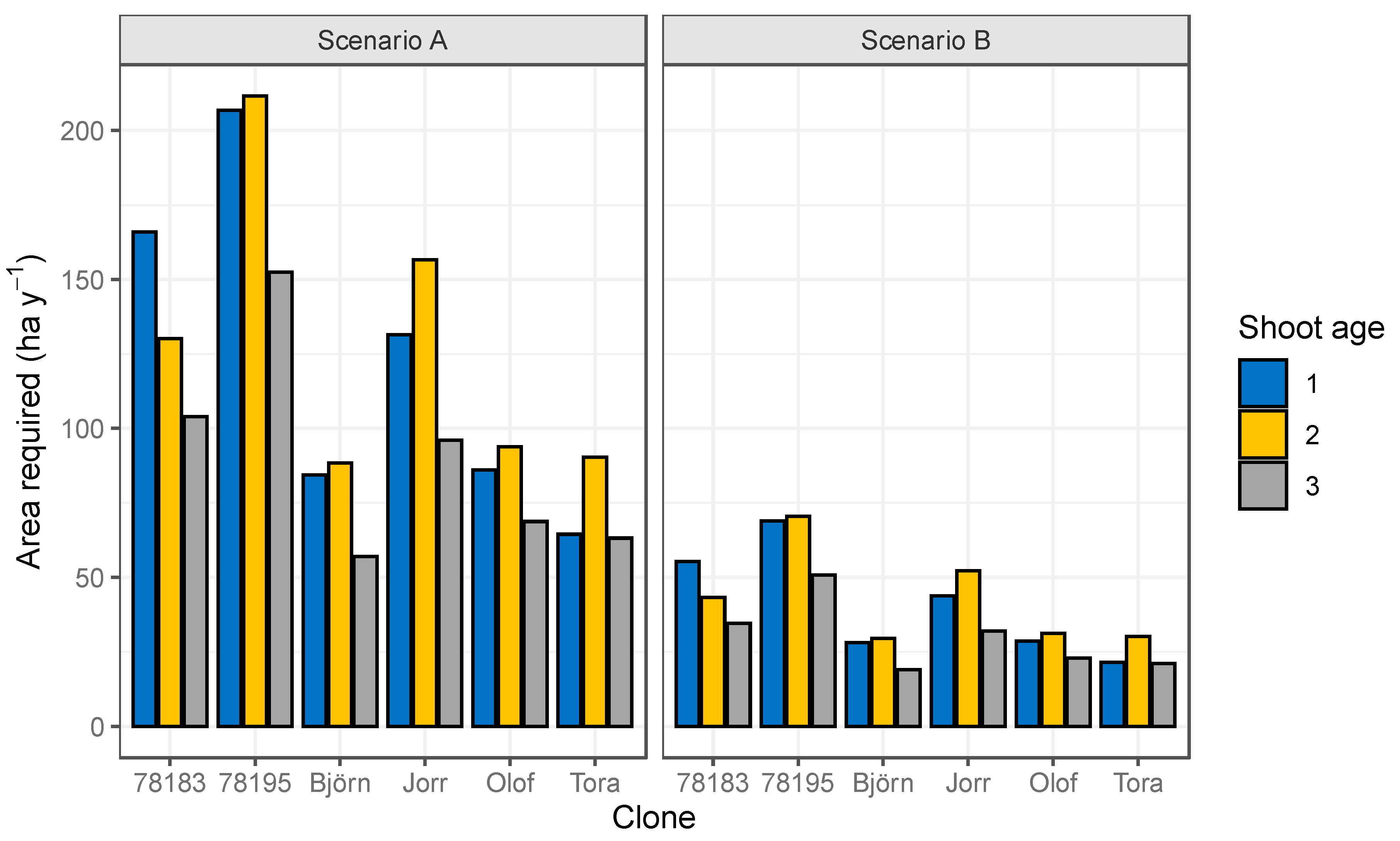
| Clone | Shoot Age | ||
|---|---|---|---|
| 1 | 2 | 3 | |
| 78183 | 140.5 (±10.9) | 180.2 (±11.6) | 154.4 (±17.9) |
| 78195 | 132.3 (±8.4) | 186.8 (±8.5) | 142.0 (±18.4) |
| Björn | 125.8 (±7.0) | 177.2 (±5.6) | 159.2 (±9.0) |
| Jorr | 159.3 (±6.8) | 198.3 (±12.2) | 156.0 (±15.1) |
| Olof | 127.6 (±3.3) | 187.5 (±18.2) | 125.0 (±14.7) |
| Tora | 139.8 (±7.9) | 176.5 (±13.5) | 158.0 (±22.4) |
| Parameter | Manure | Salix | Single Stage a | Sequential b |
|---|---|---|---|---|
| TS (% of wet weight) | 8.2 | 47.7 | 13.2 | 10.5 |
| VS (% of wet weight) | 6.7 | 46.7 | 11.7 | 9.1 |
| VS (% of TS) | 81.7 | 97.9 | 88.6 | 86.7 |
| Total N (g kg−1) | 4.5 | 2.4 | 4.2 | 4.8 |
| Organic N (g kg−1) | 2.1 | 2.4 | 2.1 | 1.6 |
| -N (g kg−1) | 2.4 | 0.0 | 2.1 | 3.3 |
| Total C (g kg−1) | 38 | 215 | 60 | 50 |
| C/N (TotC/TotN) | 8.4 | 88.7 | 14.2 | 10.4 |
| Total P (g kg−1) | 0.51 | 0.15 | 0.46 | 0.52 |
| K (g kg−1) | 4.2 | 0.5 | 3.9 | 3.8 |
| Mg (g kg−1) | 0.51 | 0.15 | 0.48 | 0.50 |
| Ca (g kg−1) | 1.3 | 1.8 | 1.5 | 1.5 |
| Na (g kg−1) | 0.1 | 0.0 | 0.07 | 0.06 |
| S (g kg−1) | 0.5 | 0.15 | 0.39 | 0.38 |
| Parameter | Co-Digestion | ||
|---|---|---|---|
| Manure | Single Stage | Sequential | |
| Specific methane production (NmL (g VS)−1) | 176 | 122 | 192 |
| Volumetric methane production (NmL L−1 d−1) | 264 | 367 | 577 |
| OLR (g L−1 d−1) | 1.5 | 3.0 | 3.0 a |
| HRT (d, average) | 36 | 36 | 36 + 40 b |
| Parameter | Co-Digestion | ||
|---|---|---|---|
| Manure | Single Stage a | Sequential | |
| TS (% of wet weight) | 6.2 | 10.5 | 6.1 |
| VS (% of wet weight) | 4.7 | 9.1 | 5.3 |
| VS (% of TS) | 75.3 | 86.7 | 86.9 |
| Total N (g kg−1) | 5.0 | 4.8 | 4.3 |
| Organic N (g kg−1) | 1.5 | 1.6 | 1.4 |
| -N (g kg−1) | 3.5 | 3.3 | 2.8 |
| Total C (g kg−1) | 26 | 50 | 26 |
| C/N (TotC/TotN) | 5.2 | 10.4 | 6.1 |
| Total P (g kg−1) | 0.58 | 0.52 | 0.53 |
| K (g kg−1) | 4.4 | 3.8 | 4.3 |
| Mg (g kg−1) | 0.52 | 0.50 | 0.50 |
| Ca (g kg−1) | 1.3 | 1.5 | 1.3 |
| Na (g kg−1) | 0.13 | 0.06 | 0.17 |
| S (g kg−1) | 0.42 | 0.38 | 0.37 |
| Manure Control | Scenario A | Scenario B | |||
|---|---|---|---|---|---|
| Single Stage | Sequential | Single Stage | Sequential | ||
| Specific methane production (NmL (g VS)−1) | 176 | 122 | 192 | 149 | 184 |
| Volumetric methane production (NmL L−1 d−1) | 264 | 367 | 577 | 316 | 421 |
| Yearly methane production for 1000 m3 digester (m3 y−1) | 96,500 | 134,200 | 210,700 | 115,400 | 153,800 |
| Gross energy yield for 1000 m3 digester (TJ y−1) | 3.6 | 5.0 | 7.8 | 4.3 | 5.7 |
| OLR (g L−1 d−1) | 1.5 | 3.0 | 3.0 a | 2.0 | 2.0 a |
| HRT (d, average) | 36 | 36 | 36 + 40 b | 36 | 36 + 40 b |
© 2020 by the authors. Licensee MDPI, Basel, Switzerland. This article is an open access article distributed under the terms and conditions of the Creative Commons Attribution (CC BY) license (http://creativecommons.org/licenses/by/4.0/).
Share and Cite
Ohlsson, J.A.; Rönnberg-Wästljung, A.-C.; Nordh, N.-E.; Schnürer, A. Co-Digestion of Salix and Manure for Biogas: Importance of Clone Choice, Coppicing Frequency and Reactor Setup. Energies 2020, 13, 3804. https://doi.org/10.3390/en13153804
Ohlsson JA, Rönnberg-Wästljung A-C, Nordh N-E, Schnürer A. Co-Digestion of Salix and Manure for Biogas: Importance of Clone Choice, Coppicing Frequency and Reactor Setup. Energies. 2020; 13(15):3804. https://doi.org/10.3390/en13153804
Chicago/Turabian StyleOhlsson, Jonas A., Ann-Christin Rönnberg-Wästljung, Nils-Erik Nordh, and Anna Schnürer. 2020. "Co-Digestion of Salix and Manure for Biogas: Importance of Clone Choice, Coppicing Frequency and Reactor Setup" Energies 13, no. 15: 3804. https://doi.org/10.3390/en13153804





